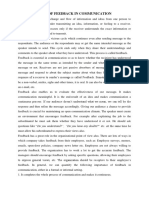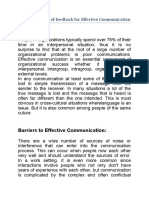0 ratings0% found this document useful (0 votes)
16 viewsFeedback
Feedback
Uploaded by
Nithya Shree PFeedback is information about how one is doing in an effort to reach a goal. It completes two-way communication and provides understanding of whether a message was successfully delivered. There are several advantages to feedback, including that it provides a basis for problem-solving, allows for democratic participation, and helps identify areas for improvement. Effective feedback is descriptive, focuses on behavior rather than people, and helps the receiver understand the feedback through questions.
Copyright:
© All Rights Reserved
Available Formats
Download as DOCX, PDF, TXT or read online from Scribd
Feedback
Feedback
Uploaded by
Nithya Shree P0 ratings0% found this document useful (0 votes)
16 views6 pagesFeedback is information about how one is doing in an effort to reach a goal. It completes two-way communication and provides understanding of whether a message was successfully delivered. There are several advantages to feedback, including that it provides a basis for problem-solving, allows for democratic participation, and helps identify areas for improvement. Effective feedback is descriptive, focuses on behavior rather than people, and helps the receiver understand the feedback through questions.
Original Description:
Nope
Copyright
© © All Rights Reserved
Available Formats
DOCX, PDF, TXT or read online from Scribd
Share this document
Did you find this document useful?
Is this content inappropriate?
Feedback is information about how one is doing in an effort to reach a goal. It completes two-way communication and provides understanding of whether a message was successfully delivered. There are several advantages to feedback, including that it provides a basis for problem-solving, allows for democratic participation, and helps identify areas for improvement. Effective feedback is descriptive, focuses on behavior rather than people, and helps the receiver understand the feedback through questions.
Copyright:
© All Rights Reserved
Available Formats
Download as DOCX, PDF, TXT or read online from Scribd
Download as docx, pdf, or txt
0 ratings0% found this document useful (0 votes)
16 views6 pagesFeedback
Feedback
Uploaded by
Nithya Shree PFeedback is information about how one is doing in an effort to reach a goal. It completes two-way communication and provides understanding of whether a message was successfully delivered. There are several advantages to feedback, including that it provides a basis for problem-solving, allows for democratic participation, and helps identify areas for improvement. Effective feedback is descriptive, focuses on behavior rather than people, and helps the receiver understand the feedback through questions.
Copyright:
© All Rights Reserved
Available Formats
Download as DOCX, PDF, TXT or read online from Scribd
Download as docx, pdf, or txt
You are on page 1of 6
What is feedback?
Feedback is not advice, praise, or
evaluation. Feedback is information
about how one is doing in effort to
reach a goal. There are two types of
feedback-giving and receiving- and
both are not the easiest.
Understanding how to give feedback
and to receive feedback is important
in a leadership role.
Feedback is:
o Written comments
o Electronic Comments
o Meetings with individuals
o Suggestions from peers
7 Advantages or Importance of
Feedback in Communication: Do we
really need Feedback?
302
Feedback is important in two-way communication. It completes
two-way communications and provides a basis of understanding
regarding the successful delivery of a message. The advantages
or importance of feedback are highlighted below.
1. Basis of problem-solving: In two-way communication,
feedback is compulsory. The sender can only justify the attitude
of the receiver if the feedback is provided. So, feedback ‘
ensures the basis of problem-solving and this is one of the
importance of feedback.
2. Democratic approach: It is a democratic approach to
communication. It involves the participation of the receiver and
therefore provides scope to express an opinion. It is another
advantage of feedback.
3. Effective communication: Two-way communication gets
confirmed that the message is rightly sent and can understand
the success or failure of communication.
4. Identification of Improvement Area: Feedback gives input
to the sender regarding the message provided by him. This
helps to improve the communication problem.
5. Better understanding: Feedback helps to understand the
view and opinion of the receiver. With a better understanding,
the sender decides on the next step.
6. Creating healthy relations: One-way communication cannot
create healthy relationships in the case of labor management.
Hence two-way communications are effective and therefore
lower-level employees can depend on feedback to raise their
voices.
7. Effective coordination: Feedback enables effective
coordination in an organization. All concerned departments can
share the work-in-progress through the means of feedback. It
supports the successful completion of a job or transaction.
GUIDELINES FOR CONSTRUCTIVE FEEDBACK
1. Acknowledge the need for Feedback
2. Give Both Positive and Negative Feedback
3. Understand the context
4. Provide Definitions: Terms, Meanings, Use Examples
and Illustrations
5. Use Common Language
6. Don’t Assume that the other person is on the same page
as you
7. Focus on Behavior Rather than People: Address
Hostility, Fear and Defensiveness
8. Know When to give Feedback
9. Know How to Give Feedback
KNOW WHEN NOT TO GIVE FEEDBACK
1. Unsure background/Circumstances
2. Hit and run feedback not fair: To be not around during
the process
3. Feedback topic on which the person has no power to
change.
4. Person is low in self-esteem
5. You, yourself is in low spirits
6. You are not giving feedback to improve but criticize and
put the person in a tight spot.
7. Inappropriate Time, Place, Circumstances
KNOWING HOW TO GIVE EFFECTIVE FEEDBACK
1. Be Descriptive
2. Be Objective
3. Don’t use Labels
4. Don’t Exaggerate
5. Don’t be Judgemental
6. Speak for yourself
7. Talk first about yourself and not about the other person
8. Phrase the Issue as a Statement , Not as a Question
9. Encourage People to Change
10. Restrict your feedback to Things you Know for Certain
11. Build Trust
12. Help People Hear and Accept Your Compliments When
Giving Positive Feedback
Knowing How to Receive Feedback
1. Breathe
2. Listen Carefully
3. Ask Questions for Clarity
4. Acknowledge the Feedback
5. Acknowledge Valid Points
6. Don’t be Defensive
7. Try To understand the other person’s objectives
8. Take Time Out to Sort out what you Heard
You might also like
- Building Relationships by Communicating SupportivelyDocument6 pagesBuilding Relationships by Communicating SupportivelyShagufta Ali100% (1)
- Communication Skills Class 10 Notes PDFDocument15 pagesCommunication Skills Class 10 Notes PDFSasi Kala96% (28)
- Lead Workplace CommunicationDocument8 pagesLead Workplace CommunicationEsubalew Gonderew100% (3)
- What Is Constructive FeedbackDocument4 pagesWhat Is Constructive FeedbackDhrubajyoti SaikiaNo ratings yet
- Interviewing Techniques in CaseworkDocument11 pagesInterviewing Techniques in CaseworkAbd ur Rehman Vlogs & Videos100% (1)
- Openness To FeedbackDocument21 pagesOpenness To FeedbackBhavanya RavichandrenNo ratings yet
- LECTURE 06 Feed Back and Giving Constructive FeedbackDocument16 pagesLECTURE 06 Feed Back and Giving Constructive Feedbackwaheed shahzadNo ratings yet
- FEEDBACK AND DUTY ALLOCATIONPRESENTATION SLIDESDocument11 pagesFEEDBACK AND DUTY ALLOCATIONPRESENTATION SLIDESmmashauri3No ratings yet
- Feedback, Its Importance & TypesDocument19 pagesFeedback, Its Importance & TypesBatool ZaidiNo ratings yet
- Feedback in Communication: Prof. Pooja MohantyDocument20 pagesFeedback in Communication: Prof. Pooja MohantyManju EkkaNo ratings yet
- Group01 SummaryChapter6Document8 pagesGroup01 SummaryChapter6minh hoangNo ratings yet
- Performance Management: Supervisor & Employee GuideDocument14 pagesPerformance Management: Supervisor & Employee GuideSarvinay100% (1)
- MB0039 Business CommunicationDocument11 pagesMB0039 Business CommunicationKilash JainNo ratings yet
- Types of Feedback Ayush Bhai TambeDocument18 pagesTypes of Feedback Ayush Bhai TambeVarun GaikwadNo ratings yet
- Role of Feedback in CommunicationDocument2 pagesRole of Feedback in CommunicationSabhaya ChiragNo ratings yet
- The Importance of Effective CommunicationDocument5 pagesThe Importance of Effective CommunicationAbhishek GuptaNo ratings yet
- FeedbackDocument7 pagesFeedbackAneela khanNo ratings yet
- Communicating and Managing Communication (7 Readings)Document20 pagesCommunicating and Managing Communication (7 Readings)Ahmed DahiNo ratings yet
- Constructive FeedbackDocument5 pagesConstructive FeedbackBerra MkhNo ratings yet
- UNIT-4Document10 pagesUNIT-4Jeru ElbanbuenaNo ratings yet
- Abhishek 10tha J Feedback in CommunicationDocument19 pagesAbhishek 10tha J Feedback in CommunicationAbhishek KumarNo ratings yet
- AI PART A and PART B IMP-1Document13 pagesAI PART A and PART B IMP-1ರವಿ ಶ್ರೀಜಿತ್No ratings yet
- Communication in Everyday LifeDocument97 pagesCommunication in Everyday Lifejasleenk1324No ratings yet
- COMMUNICATION Module 2 220107Document8 pagesCOMMUNICATION Module 2 220107wubeNo ratings yet
- Topic 8 Chapter 6 Communication Coaching and Conflict SkillsDocument36 pagesTopic 8 Chapter 6 Communication Coaching and Conflict SkillsLing Meng Cynthia100% (2)
- Work With Other PPT 2014Document33 pagesWork With Other PPT 2014Moti TadegeNo ratings yet
- Communication Notes For AIDocument5 pagesCommunication Notes For AIxxslmll814No ratings yet
- 5 FeedbackDocument27 pages5 FeedbackNabil JefriNo ratings yet
- Unit 3 Transactional Communication: Communication StrategiesDocument12 pagesUnit 3 Transactional Communication: Communication StrategiesCielo PulmaNo ratings yet
- Modele de Retroaferentatie Inversa in ComunicaeDocument3 pagesModele de Retroaferentatie Inversa in ComunicaeMarius ConstantinNo ratings yet
- Section 11 Giving and Receiving FeedbackDocument11 pagesSection 11 Giving and Receiving FeedbackgreenwellNo ratings yet
- Formal Communication: Short Questions 1. Distinguish Between The Formal and The Informal CommunicationDocument14 pagesFormal Communication: Short Questions 1. Distinguish Between The Formal and The Informal Communicationmadhavi singhNo ratings yet
- Business CommunicationDocument26 pagesBusiness CommunicationReehab ShaikhNo ratings yet
- BusComSemIInotesDocument55 pagesBusComSemIInotesGuru Fire ServicesNo ratings yet
- Mba 2022Document10 pagesMba 2022Akshay KulkarniNo ratings yet
- AI NOTESDocument136 pagesAI NOTESmrutyunjaimohandNo ratings yet
- Delivering Negative Feedback with Empathy and Effectiveness: Giving and Receiving Feedback for SuccessFrom EverandDelivering Negative Feedback with Empathy and Effectiveness: Giving and Receiving Feedback for SuccessNo ratings yet
- Communication Skills Class 10 Notes PDFDocument36 pagesCommunication Skills Class 10 Notes PDFcbjpjyfcgrNo ratings yet
- The Heart of Managerial ProcessDocument72 pagesThe Heart of Managerial Processmindreader19No ratings yet
- Business Communication 1st PhaseDocument24 pagesBusiness Communication 1st PhaseNazmul HossenNo ratings yet
- IT Class 10 Notes Term Examination - 10Document42 pagesIT Class 10 Notes Term Examination - 10Shivanshu AnandNo ratings yet
- Feedback - GuidelinesDocument10 pagesFeedback - GuidelinesAmandyta FonsecaNo ratings yet
- Topic Workbook - Feedback and Constructive CriticismDocument11 pagesTopic Workbook - Feedback and Constructive CriticismMashiur RahmanNo ratings yet
- Chapter No 6 of LeadrshipDocument28 pagesChapter No 6 of LeadrshipHooriya KhanNo ratings yet
- Emploability Notes Class XDocument21 pagesEmploability Notes Class Xashumafia2009No ratings yet
- Care Enhancement Qualities: Objective: Demonstrate The Caring Behavior in All His/her Activities As Manifested byDocument41 pagesCare Enhancement Qualities: Objective: Demonstrate The Caring Behavior in All His/her Activities As Manifested byMabelle Guray AcacNo ratings yet
- Fnc305: Fndamentals of Resource Management CommunicationDocument5 pagesFnc305: Fndamentals of Resource Management CommunicationEsther GeorgeNo ratings yet
- Running Head: THE ART OF FEEDBACK 1Document8 pagesRunning Head: THE ART OF FEEDBACK 1John O'BrianNo ratings yet
- Assertive Communication For ManagerDocument4 pagesAssertive Communication For ManagerSasank AravapalliNo ratings yet
- Communication skills (1)Document12 pagesCommunication skills (1)mohandlava22No ratings yet
- BCommManagers 11Document30 pagesBCommManagers 11kapil shahNo ratings yet
- Team Process IssuesDocument12 pagesTeam Process IssuesMD Al Hasan MahmudNo ratings yet
- Counselling Skills and TechniquesDocument29 pagesCounselling Skills and TechniquesWanda Lywait100% (1)
- Class 10 IT 402 NotesDocument19 pagesClass 10 IT 402 NotesRakesh palNo ratings yet
- ROHITBISHT.20551359.MOOC PPT Sem1Document15 pagesROHITBISHT.20551359.MOOC PPT Sem1rohit bishtNo ratings yet
- Soft Skills Abdullah AbushareiaDocument11 pagesSoft Skills Abdullah AbushareiaMaen OtoumNo ratings yet
- What Is FeedbackDocument8 pagesWhat Is Feedbackdjrao81No ratings yet
- MAMA Facilitative RespondingDocument3 pagesMAMA Facilitative RespondingLaiNe de la PazNo ratings yet
- Constructive Feedback: The essentials of giving and receiving constructive criticismFrom EverandConstructive Feedback: The essentials of giving and receiving constructive criticismNo ratings yet
- SOC 1502 Written Assignment Unit 1Document5 pagesSOC 1502 Written Assignment Unit 1se7sbomb5297No ratings yet
- Emotional Needs & DesiresDocument12 pagesEmotional Needs & DesiresMaria Elizabeth YbanezNo ratings yet
- Abhilasha Module 2Document63 pagesAbhilasha Module 2Pankaj RaiNo ratings yet
- Unconditional Self-Acceptance and Psychological Health: John M. Chamberlain David A. F. HaagaDocument14 pagesUnconditional Self-Acceptance and Psychological Health: John M. Chamberlain David A. F. HaagaAlfonso LeeNo ratings yet
- Personal Development: Demonstrate and Create Ways To Manage Various EmotionsDocument22 pagesPersonal Development: Demonstrate and Create Ways To Manage Various EmotionsIzanagi Nomura100% (2)
- Self in Eastern and Western ThoughtDocument47 pagesSelf in Eastern and Western ThoughtRica TantoyNo ratings yet
- Status and Emotions in Russian Foreign PolicyDocument101 pagesStatus and Emotions in Russian Foreign PolicyYazminNo ratings yet
- 十三个万能理由 托福写作Document3 pages十三个万能理由 托福写作Michelle RenNo ratings yet
- 10 Things To Boost Self-Esteem - UTSDocument2 pages10 Things To Boost Self-Esteem - UTSjoannachelcalayag.10No ratings yet
- Ahmad, Tekke 2015 Rediscovering Roger's Self Theory and PersonalityDocument9 pagesAhmad, Tekke 2015 Rediscovering Roger's Self Theory and PersonalitykwnNo ratings yet
- 1Document12 pages1leomar ignacioNo ratings yet
- Cybercrime PsyhologyDocument45 pagesCybercrime PsyhologySamuelNo ratings yet
- Abraham MaslowDocument42 pagesAbraham Maslowkavitha nagarjunakondaNo ratings yet
- Local Media5424734128943221778Document21 pagesLocal Media5424734128943221778Welson M. BersanoNo ratings yet
- Reviewer in Uts (Midterm Exam)Document10 pagesReviewer in Uts (Midterm Exam)Shane Margarette PalicpicNo ratings yet
- Eng Notes Term 1Document14 pagesEng Notes Term 1Marinette ElsNo ratings yet
- Housing by People, Towards Autonomy in Building Environments - John F. C. Turner PDFDocument205 pagesHousing by People, Towards Autonomy in Building Environments - John F. C. Turner PDFffarq90No ratings yet
- Soft Skills: - DR Shweta Sharma, MAITDocument67 pagesSoft Skills: - DR Shweta Sharma, MAITchirag goyel100% (2)
- IRIS Bengkel Coaching For Performance (PowerPoint Presentation)Document28 pagesIRIS Bengkel Coaching For Performance (PowerPoint Presentation)Adam ZulkifliNo ratings yet
- Effects of Self Esteem On Mental HealthDocument5 pagesEffects of Self Esteem On Mental HealthMaryam RashidNo ratings yet
- AFFECTIVE FACTORS-Group 6Document13 pagesAFFECTIVE FACTORS-Group 6lissa de los santosNo ratings yet
- Reflective Essay 2 (The Family Affair)Document5 pagesReflective Essay 2 (The Family Affair)brighteducentresiNo ratings yet
- 202 Adame CircleTimeDocument10 pages202 Adame CircleTimeUtah Association for the Education of Young Children100% (1)
- Cain, Pincus, Ansell, 2008 Narcissism at The Crossroads, Phenotypic Description of PathologicalDocument19 pagesCain, Pincus, Ansell, 2008 Narcissism at The Crossroads, Phenotypic Description of Pathologicaljuaromer100% (1)
- Researchpaper MakaylacampbellDocument8 pagesResearchpaper Makaylacampbellapi-534501775No ratings yet
- A Study On Effectiveness of Rewards System of Motivational Level of The Employee in Maruthi Suzuki Showroom at Indus Motors Pathanamthittta, KeralaDocument31 pagesA Study On Effectiveness of Rewards System of Motivational Level of The Employee in Maruthi Suzuki Showroom at Indus Motors Pathanamthittta, Keralaananthakumar100% (1)
- Housing AND The Human NeedsDocument58 pagesHousing AND The Human NeedsvalNo ratings yet
- The Problem and It'S SettingDocument32 pagesThe Problem and It'S SettingMara PundavelaNo ratings yet
- Woman S Era Sep 20Document116 pagesWoman S Era Sep 20Balvinder Singh RamgarhiaNo ratings yet
- Research Topic The Impact of Talent Management On Job SatisfactionDocument16 pagesResearch Topic The Impact of Talent Management On Job Satisfactionjannat farooqiNo ratings yet

























































































